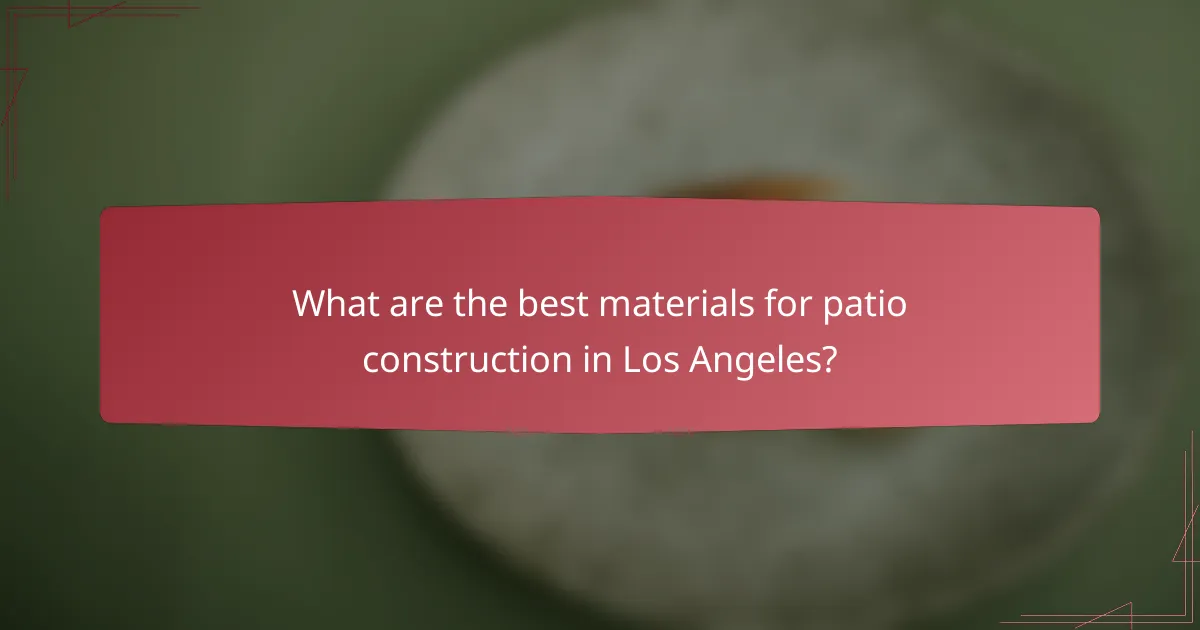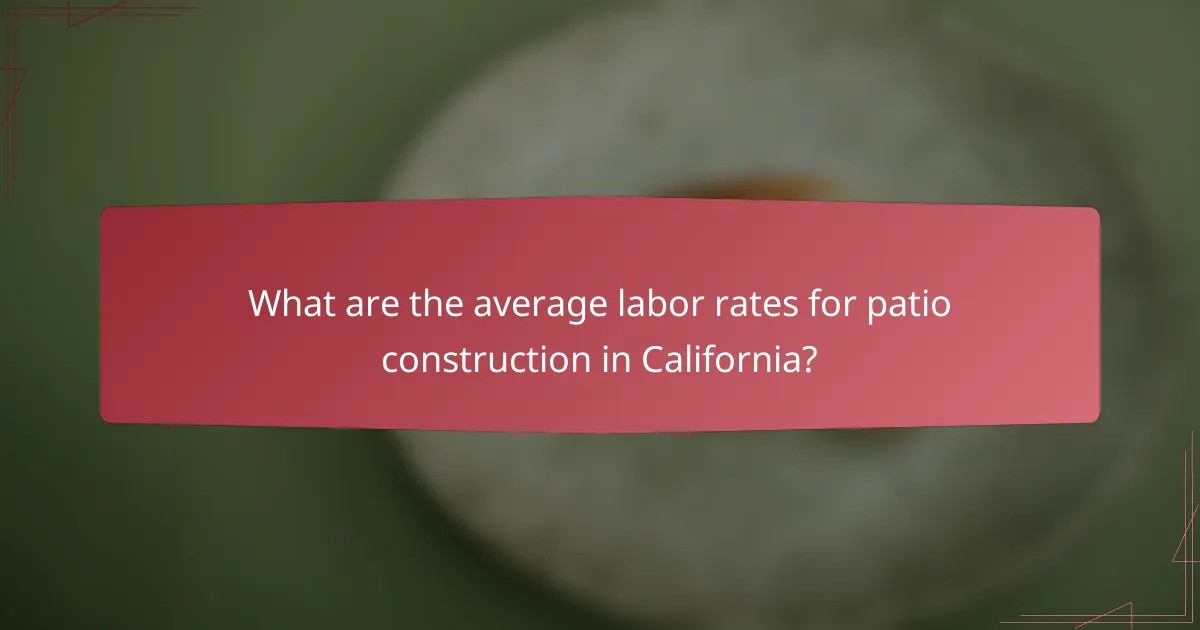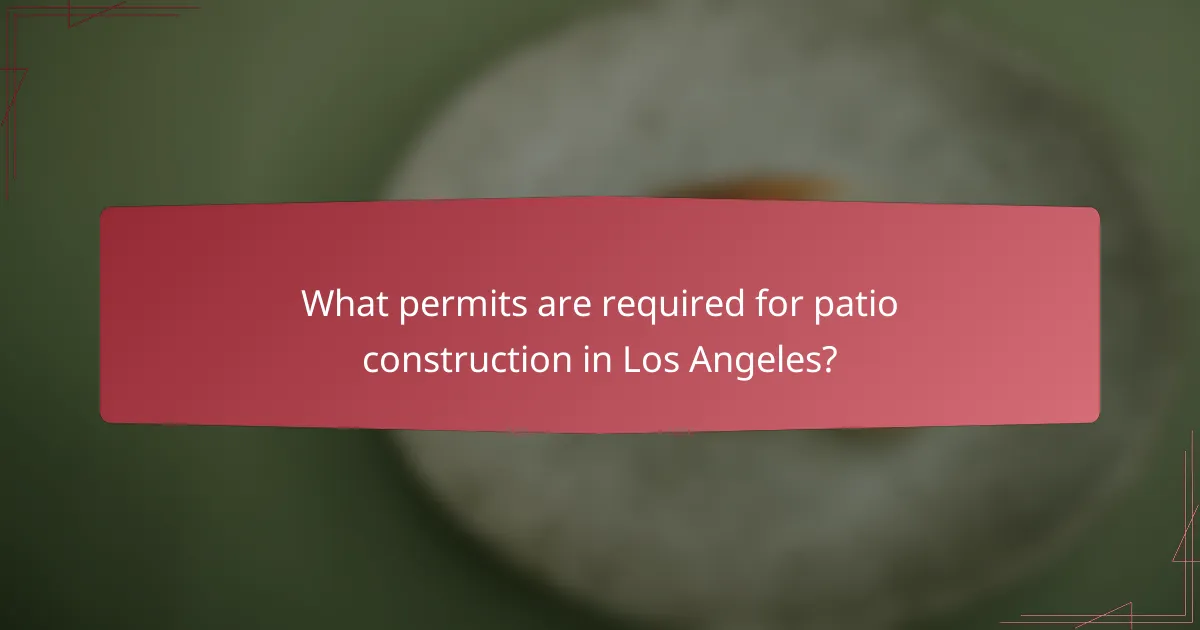When planning a patio construction project, selecting the right materials is crucial for achieving both durability and aesthetic appeal. Options such as concrete pavers, natural stone, and composite decking each come with distinct advantages, making it important to align your choice with your lifestyle and maintenance preferences. Additionally, thoughtful design considerations and an understanding of labor rates, which typically range from $50 to $100 per hour in California, will help ensure your project stays within budget and meets your vision.

What are the best materials for patio construction in Los Angeles?
The best materials for patio construction in Los Angeles include concrete pavers, natural stone, composite decking, brick, and tile. Each material offers unique benefits and considerations, making it essential to choose based on aesthetics, durability, and maintenance needs.
Concrete pavers
Concrete pavers are a popular choice for patios in Los Angeles due to their durability and versatility. They come in various shapes, sizes, and colors, allowing for creative designs. Installation is relatively straightforward, and they can withstand the region’s climate effectively.
When selecting concrete pavers, consider the thickness and texture, as these factors influence longevity and slip resistance. Proper installation with a solid base is crucial to prevent shifting and cracking over time.
Natural stone
Natural stone, such as flagstone or slate, provides a timeless and elegant look for patios. Each stone has unique colors and textures, contributing to a distinctive appearance. However, natural stone can be more expensive than other materials, often ranging from moderate to high prices per square foot.
Keep in mind that natural stone requires sealing to protect against stains and weathering. Additionally, the uneven surfaces may require more maintenance to ensure safety and comfort.
Composite decking
Composite decking is an excellent option for those seeking a low-maintenance patio material. Made from a blend of wood fibers and plastic, it resists fading, staining, and warping. This material is particularly appealing in Los Angeles, where outdoor living is popular.
While composite decking can be more costly upfront compared to traditional wood, its durability and reduced maintenance needs can lead to long-term savings. Ensure proper ventilation during installation to prevent moisture buildup.
Brick
Brick patios offer a classic and rustic charm, making them a favored choice in many Los Angeles homes. They are durable and can last for decades with proper care. Bricks are available in various colors and can be arranged in different patterns for aesthetic appeal.
Consider the installation method, as bricks require a solid base and proper jointing to prevent shifting. Regular maintenance, such as cleaning and resealing, will help maintain their appearance and longevity.
Tile
Tile is a versatile patio material that can add color and style to outdoor spaces. Available in ceramic, porcelain, and stone varieties, tiles can withstand the elements and are easy to clean. In Los Angeles, outdoor tiles can enhance the aesthetic of a patio while providing a cool surface underfoot.
When choosing tile, consider slip resistance, especially in areas exposed to water. Proper installation is key to avoid cracking, so hiring a professional may be beneficial for optimal results.

How to choose the right design for your patio?
Choosing the right design for your patio involves considering your space, lifestyle, and aesthetic preferences. Key factors include layout, levels, and how the patio integrates with your landscaping.
Open layout
An open layout for your patio maximizes space and provides a seamless transition between indoor and outdoor areas. This design is ideal for entertaining, as it allows for easy movement and flow during gatherings.
When planning an open layout, consider using large tiles or pavers to create a unified look. Ensure there is adequate seating and table space to accommodate guests comfortably.
Multi-level design
A multi-level design adds visual interest and can help define different areas for various activities, such as dining, lounging, or gardening. This approach is particularly beneficial for sloped yards, where terraces can be created to follow the natural contours of the land.
To implement a multi-level design, think about using steps or ramps for accessibility. Consider materials that complement each level, such as wood decking for one area and stone for another, to enhance the overall aesthetic.
Integrated landscaping
Integrating landscaping with your patio design creates a cohesive outdoor space that feels inviting and harmonious. This can include planting beds, water features, or decorative elements that blend with the patio materials.
When planning for integrated landscaping, choose plants that thrive in your climate and require minimal maintenance. Use native species to enhance biodiversity and reduce water usage, ensuring your patio remains a sustainable part of your yard.

What are the average labor rates for patio construction in California?
The average labor rates for patio construction in California typically range from $50 to $100 per hour, depending on the contractor’s experience and the complexity of the project. Homeowners should budget for these rates when planning their patio projects, as labor costs can significantly impact the overall expense.
Hourly rates for contractors
Hourly rates for contractors in California can vary widely based on their expertise and the region. Generally, skilled laborers may charge between $60 and $90 per hour, while general contractors might command rates closer to $80 to $120 per hour. It’s advisable to obtain multiple quotes to ensure competitive pricing.
Cost per square foot
The cost per square foot for patio construction in California usually falls between $10 and $30, depending on the materials used and the design complexity. For example, a simple concrete patio may cost less per square foot compared to a more intricate stone or paver design. Always consider the total area when estimating costs to avoid surprises.
Factors affecting labor costs
Several factors can influence labor costs for patio construction, including the project’s location, the contractor’s experience, and the chosen materials. Urban areas may see higher labor rates due to increased demand, while rural locations might offer lower prices. Additionally, specialized designs or difficult site conditions can lead to increased labor expenses.
It’s also essential to consider the time of year, as labor rates can fluctuate based on seasonal demand. Planning your project during off-peak seasons may yield cost savings. Always discuss potential additional costs upfront with your contractor to ensure a clear understanding of the total project budget.

What permits are required for patio construction in Los Angeles?
In Los Angeles, constructing a patio typically requires several permits to ensure compliance with local regulations. These permits help maintain safety standards and zoning laws, which can vary based on the specific location and design of the patio.
Building permits
Building permits are essential for any patio construction in Los Angeles. These permits ensure that the structure meets safety codes and construction standards. Homeowners should apply for a building permit through the Los Angeles Department of Building and Safety, providing detailed plans and specifications for the patio.
Typically, the cost of a building permit can range from a few hundred to over a thousand dollars, depending on the size and complexity of the project. It’s advisable to check the current fee schedule on the city’s official website.
Zoning approvals
Zoning approvals are necessary to confirm that the patio complies with local zoning laws. These laws dictate how land can be used and may restrict the size, height, and placement of the patio on the property. Homeowners should consult the Los Angeles Planning Department to determine any zoning restrictions that may apply.
Obtaining zoning approval may involve submitting an application and possibly attending a public hearing, especially if the project deviates from standard zoning regulations. It’s crucial to address these requirements early in the planning process to avoid delays.
Environmental regulations
Environmental regulations in Los Angeles may impact patio construction, particularly if the project affects local ecosystems or involves significant land alteration. Homeowners should be aware of regulations regarding stormwater management and the protection of native plants and wildlife.
In some cases, an environmental review may be necessary, especially for larger projects. Consulting with a professional familiar with local environmental laws can help navigate these requirements effectively and ensure compliance.

What are the key factors influencing patio construction costs?
The main factors influencing patio construction costs include material selection, design complexity, and site preparation. Each of these elements plays a significant role in determining the overall budget and feasibility of the project.
Material selection
Choosing the right materials is crucial for controlling patio construction costs. Common options include concrete, pavers, natural stone, and wood, each with varying price points and durability. For instance, concrete tends to be more affordable, while natural stone can be significantly more expensive but offers a unique aesthetic.
Consider the long-term maintenance and lifespan of materials as well. For example, while wood may have a lower initial cost, it often requires more upkeep compared to stone or concrete. Weighing these factors can help you make a more informed decision.
Design complexity
The complexity of your patio design directly impacts labor costs and the overall budget. Simple, rectangular shapes are generally less expensive to construct than intricate designs with curves or multiple levels. More complex designs may require specialized skills and additional time, leading to higher labor rates.
When planning your patio, consider how the design will integrate with existing landscaping and structures. A well-thought-out design can enhance functionality and aesthetics, potentially increasing the value of your property.
Site preparation
Proper site preparation is essential for a successful patio installation and can significantly affect costs. This process may involve clearing debris, leveling the ground, and ensuring proper drainage. If the site has challenging conditions, such as rocky soil or steep slopes, additional work may be required, increasing labor costs.
It’s advisable to conduct a thorough site assessment before beginning construction. This can help identify potential challenges and allow for more accurate budgeting. Hiring a professional for this assessment can save time and money in the long run by avoiding unexpected issues during construction.

How does climate affect patio material selection?
Climate significantly influences the choice of materials for patio construction. Factors such as temperature fluctuations, humidity, and precipitation levels can determine the durability and suitability of various materials.
Temperature considerations
In regions with extreme temperatures, materials must withstand thermal expansion and contraction. For example, concrete and stone are often preferred in hot climates due to their ability to endure high heat without warping. Conversely, in colder areas, materials like wood may be more susceptible to cracking and should be treated for weather resistance.
Humidity and moisture levels
High humidity and moisture can lead to mold and mildew growth, making materials like untreated wood less suitable. Instead, consider using composite decking or stone, which are more resistant to moisture damage. In drier climates, porous materials may be more acceptable, but they should be sealed to prevent cracking.
Precipitation and drainage
Areas with heavy rainfall require materials that facilitate proper drainage to avoid pooling water. Pavers with gaps or permeable concrete can help manage water runoff effectively. It’s essential to design the patio with a slight slope to direct water away from structures, ensuring longevity and safety.



